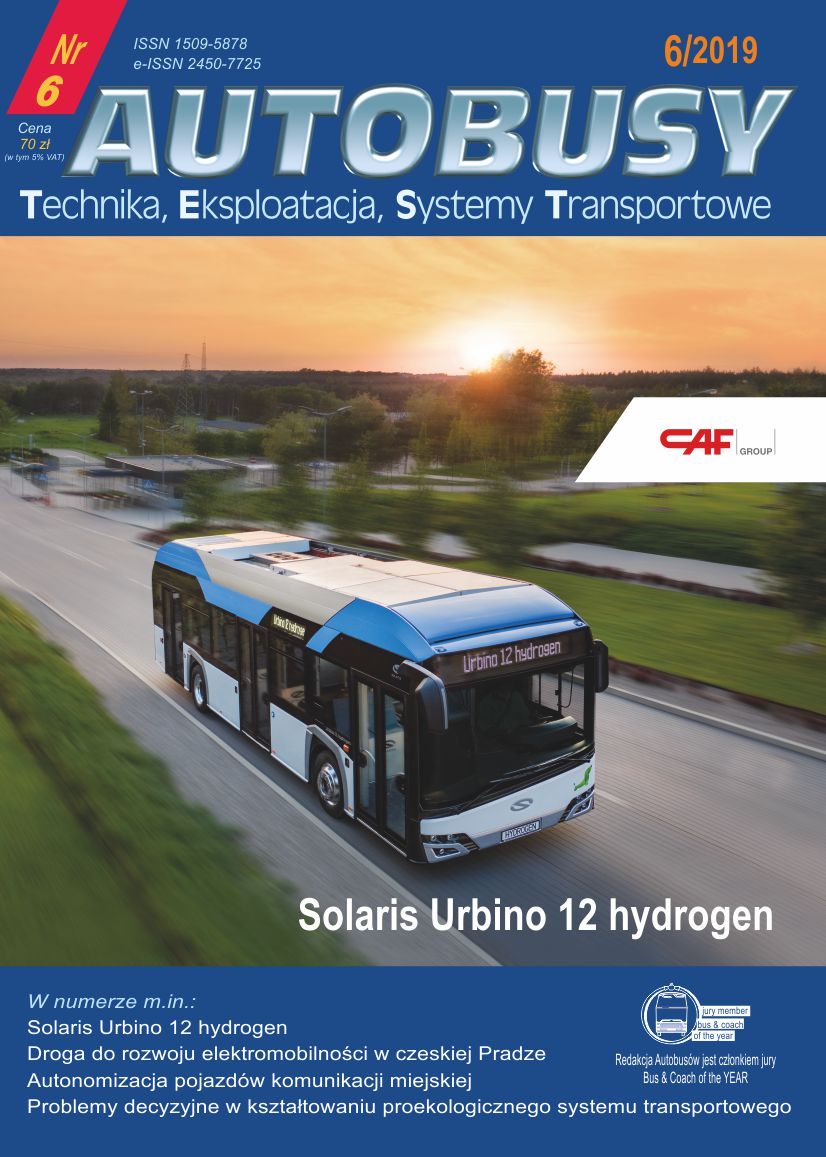The concept of the PRT traffic control and management sys-tem
DOI:
https://doi.org/10.24136/atest.2019.184Keywords:
Personal Rapid Transit, transportAbstract
The paper presented the PRT (Personal Rapid Transit) control and traffic management system. The genesis of the use of information systems for control and PRT traffic management was made. The concept of the PRT system was defined, a review of these systems and their structure was carried out. The mechanical and ergonomic systems of PRT vehicles have been described. The chassis structure and the ergonomics of the PRT vehicle cabs have been characterized. The process of estimating traffic conditions and simulations of exemplary PRT vehicles have been described. An analysis of the PRT system was carried out, the purpose of which is to determine the optimal number of PRT stations guaranteeing optimal service provision, in terms of the demand for PRT services. The stages of designing the PRT circulation system for districts on the outskirts of the city are illustrated. The OPTIMAL program tool (C-CAD) has been used.
Downloads
References
Chebbi O., Chaouachi J., Reducing the wasted transportation capacity of personal rapid transit systems: an integrated model and multi-objective optimization approach, Transportation re-search part E: logistics and transportation review 2016, nr 89, s. 236-258.
Choromański W., Kowara J., The selected problems of computer aided design of PRT (Personal Rapid Transit) Vehicles, Logistyka 2010, nr 4, s. 1-9.
Daszczuk W.B., Mieścicki J., Grabski W., Empty vehicles management as a method for reducing passenger waiting time in personal rapid transit networks, IET Intelligent Transport Systems 2014, nr 9, s. 231-239.
Domański R., Zespoły sieci komunikacyjnych. Prace Geograficzne IG PAN, 41. PAN, Warszawa 1963.
Dunning B., Ford I., Personal Automated Transportation: Status and Potential of Personal Rapid Transit, Technology Evaluation January 2003.
Gadziński J., Funkcjonowanie lokalnego systemu transportowego na tle współczesnych procesów urbanizacyjnych w aglomeracji poznańskiej, Uniwersytet im. Adama Mickiewicza w Poznaniu, Po-znań.
Irving J.H., Bernstein H., Olson C.L., Buyan J., Fundamentals of Personal Rapid Transit. Based on a Program of Research at the aerospace corporation, Lexington Books, Toronto 1978.
Jonnes K., Simmons J., The Retail Environment. Routledge, Londyn 1990.
Kupiec E., Przyborowski W., Metoda wyznaczania i analiza rozkładu indukcji magnetycznej w szczelinie powietrznej silnika indukcyjnego liniowego, Zeszyty Problemowe–Maszyny Elektryczne 2013, nr 100, s. 121-126.
Li C.H.G., Design of the lower chassis of a monorail personal rapid transit (MPRT) car using the evolutionary structural optimization (ESO) method, Structural and Multidisciplinary Optimization 2016, nr 1, s. 165-175.
Mrad M., Hidri L., Optimal consumed electric energy while sequencing vehicle trips in a personal rapid transit transportation system, Computers & Industrial Engineering 2015, nr 79, s. 1-9.
Parteka T., Konstruktywna i destruktywna rola transportu w kształtowaniu treści i formy miast. Czasopismo Techniczne. Architektura 2010, 107, 1A, s. 95-109.
Personal Rapid Transit via Magnetic Levitation, Trond Andresen Department of Engineering Cybernetics The Norwegian University of Science and Technology (NTNU) Trondheim, Norway 2016.
Schneider J.B., Designing a High Performance PRT Network for an Edge City, University of Washington, Seattle, https://faculty.washington.edu/jbs/itra ns/prtconfw.htm (dostęp: 23.10.2018).
Schneider, J.B., Transit and the Polycentric City, Final Report, DOT-1-81-33, U.S. Department of Transportation, Urban Mass Transportation Administration: Washington, D.C. 1981, 294.
Schneider, J.B., Jun M., Designing Personal Rapid Transit (PRT) Networks, Journal of Advanced Transportation 1991, 25:3, s. 247-268
Schneider, J.B., A PRT Deployment Strategy to Support Regional Land Use and Rail Transit Objectives, Transportation Quarterly 1992, 46:1, 135-153.
Schneider, J.B., 1993, Designing APM Circulator Systems for Major Activity Centers : An Interactive Graphic Approach, in Proceedings, Automated Peoplemovers IV: Enhancing Values in Major Activity Centers, edited by W.J. Sproul, E.S. Neumann and M.V.A. Bondada, American Society of Civil Engineers: New York, N.Y., 535-545.
Szaruga E., Problem ekonomicznej wyceny zewnętrznych kosztów transportu drogowego w budowaniu algorytmu zrównoważonego rozwoju (Polska na tle Unii Europejskiej) (w:) Zrównoważony rozwój – Debiut naukowy 2011, T. Jemczura, H. Kretek (red.), Rada Wydawnicza Państwowej Wyższej Szkoły Zawodowej w Raciborzu, Racibórz 2012.
Taylor Z., Geografia transportu i jej wkład do teorii geografii: próba oceny, Przegląd Geograficzny 2000, nr 72, s. 491-503.
http://www.ultraglobalprt.com/wheres-it-used/heathrow-t5/ (3.07.2017).
http://www.vectusprt.com/EN/first-project/ (3.07.2017).
https://www.2getthere.eu/projects/masdar-prt/ (3.07.2017).
Masdar City Testing EVs That Drive Themselves,
https://www.fastcompany.com/1520148/masdar-city-testing-evs-drive-themselves (3.07.2017).
Morgantown, West Virginia: Personal Rapid Transit (PRT),
http://www.jtbell.net/transit/Morgantown/ (3.07.2017).
Personal Rapid Transit Deployment Plan, JPODS INC. USA, Cleaner. Faster. Safer. Affordable 2016, s. 43.
Chojnacki Michał: System informatyczny sterowania i zarządzania ruchem PRT, Praca dyplomowa magisterska, Wydział Transportu i Elektrotechniki Uniwersytetu Technologiczno-Humanistycznego im. Kazimierza Pułaskiego w Radomiu, Radom 2018 r.



